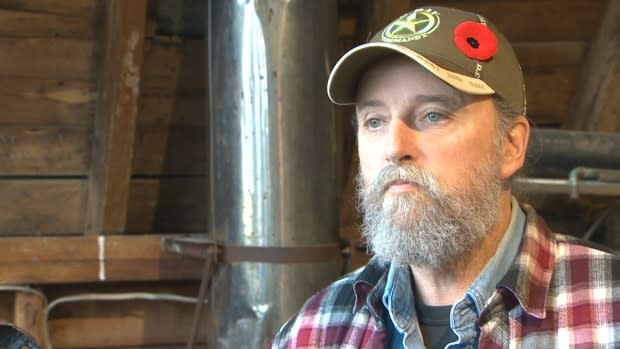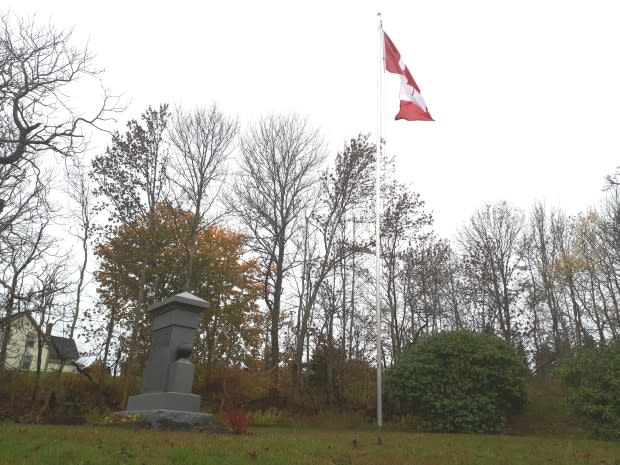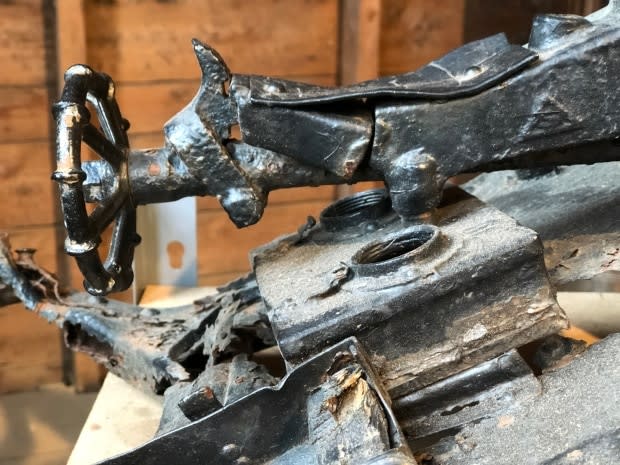Fixing a piece of WW I history a sign of respect for Yarmouth man
Ed Telfer is in the workshop of his Yarmouth, N.S., barn, cleaning up a First World War German machine gun that was damaged after being stolen from the cenotaph in nearby Arcadia.
The machine gun has two pieces: a base and barrel. Combined, the two weigh about 45 kilograms.
Other than some rusting, a faded paint job, a bent leg and a broken bracket, the gun is in reasonably good shape. A wheel on it that adjusts to aim the gun can still turn.
Telfer, who had a great-grandfather who served in the First World War, considers it his duty to repair the gun.
"Unfortunately, this gun mowed down a lot of Canadians," he said. "It killed a lot of men and those names are on cenotaphs all across Canada."
For decades, the Maxim MG 08, also known as the Devil's Paintbrush, sat unsecured on a concrete slab at the Arcadia cenotaph, nestled next to a rhododendron bush.
That all changed in May 2018 when it was stolen from the Highway 3 site, which is a stone's throw from the town line to Yarmouth.
In January, RCMP received a report the gun had been found by a man hunting in a wooded area on the Small Gaines Road in Yarmouth, just a few hundred metres away from the cenotaph.
This isn't Telfer's first time restoring the gun. He did the same thing about 10 years ago.
After the gun's latest adventure, Telfer, a motorcycle mechanic, volunteered to get it cleaned up.

"A lot of sacrifice went into getting these cenotaphs and this piece of equipment here and a lot of heartache and tears, so I think it's honouring for me to somehow show my respect to the fallen comrades from before," he said.
Telfer aims to have the gun back at the cenotaph by Nov. 11. Besides fixing the leg and the bracket that mounts the barrel to the base, he's scraping the rust off the machine gun and will give it a fresh coat of black paint.
Around 66,000 Canadians and Newfoundlanders were killed in the First World War, while more than 172,000 out of the 650,000 men and women who served were wounded, according to Veterans Affairs Canada.
Dorothy Redfurn, a member of the Arcadia Women's Institute, said she was shocked when she learned the gun was stolen from the site. The women's institute maintains the cenotaph.

"I was kind of flabbergasted and a little bit angry because, you know, leave the historical stuff alone. It's not sacred, but it should be given a bit of respect," she said.
She's looking forward to its return.
"It'll be a relief because it's kind of been galling to look and see that empty slab there and think, 'What on earth is somebody doing with our gun?' But it'll be great to get it back where it belongs," said Redfurn.
Just how the gun ended up at the cenotaph in Arcadia is unclear.
One possibility is that it came from the Victory Bonds campaign. In 1919, the federal government raised more than $600 million by selling Victory Bonds.

Counties across the country were given targets for what they were expected to raise. The county from each of Canada's nine provinces and two territories that raised the most relative to their goal would each win the ultimate prize — a piece of captured German field artillery.
In Nova Scotia, almost $28 million was raised. Yarmouth County was given an objective of $450,000, but ended up raising almost $1.17 million, 160 per cent more than its target.
"So the plucky county of Yarmouth gets the gun it so nobly earned," said an article in the Halifax Herald on Nov. 18, 1919.
It's unclear what happened to the German field artillery Yarmouth County earned.

As Telfer works on the gun, one consideration he has is whether to anchor the machine gun to the concrete pad where it sat undisturbed for decades.
"I don't want to [do that], but I thought just out of respect that it should stay here until the end of time," he said.
Getting the gun back to the site is a top priority for Telfer, given the significant role it plays in helping people remember about Canada's wartime service.
"To think of the heartache that this gun caused at one time [and] can still be on display for people to see and remember, that's what it's all about, is to remember.
"We can't forget these things. As soon as we forget the past, it rolls over and it comes again," he said.
MORE TOP STORIES


